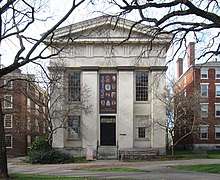Haffenreffer Museum of Anthropology
The Haffenreffer Museum of Anthropology is Brown University's teaching museum. The museum has a 2,000-square-foot (190 m2) gallery in Manning Hall on the university campus in Providence, Rhode Island. Its Collections Research Center is located in Bristol, Rhode Island.
 Haffenreffer Museum of Anthropology, housed in Manning Hall. | |
| Established | 1955 |
|---|---|
| Location | Providence, Rhode Island, United States |
| Type | Teaching museum |
| Owner | Brown University |
| Website | www |
Mission
The Haffenreffer Museum of Anthropology is Brown University’s teaching museum. A resource across the university, it aims to inspire creative and critical thinking about culture by fostering interdisciplinary understanding of the material world. It provides opportunities for faculty and students to work with collections and the public, teaching through objects and programs in classrooms, in the CultureLab and exhibitions in Manning Hall, and at the Collections Research Center.
Exhibitions
Changing exhibitions in the museum’s gallery in Manning Hall,[1] at the center of Brown University's campus, highlight the museum's collections from around the world and the work of Brown University faculty, staff and students. The museum also offers public lectures, performances, symposia, festivals, school activities, and a broad range of programs and events for all ages.
Educational programs
In addition to extensive educational programs for Brown students, centered in the CultureLab in the Manning Gallery, the Museum provides structured group programs delivered to local schools and an extensive array of public lectures.
Artifact collections
The Museum's holdings total approximately one million items. While strongest in Native North American materials, the museum also contains significant material from Latin America, Africa, the Middle East, and Asia, including:
- 900,000 archeological artifacts excavated by Arctic researchers from National Park Service and Bureau of Land Management lands in Alaska (a federal repository)
- 70,000 archeological and 6,000 ethnological objects from elsewhere in North America
- 2,500 archeological and 3,000 ethnological items from South and Central America
- 40 archeological and 3,000 ethnological items from Africa, some by contemporary artisans
- 400 archeological and 400 ethnological items from Europe
- 1,100 ethnological items from Asia
- 1,500 ethnological items from Oceania.
Image collections
The Haffenreffer Museum Research Collections Center's photographic archive, in addition to collection record shots, contains photographs from the founder's archives, the Spinden collection of images of Central and South America, and field photographs that accompanied collections. The Center library has some 10,000 volumes. Highlights of the collection include:
- Herbert Spinden Photographic Archive, with over 20,000 images and documents related to Central American archaeology and ethnography from the early 20th century, including many images of important archaeological sites that have since been altered or destroyed.
- The Kensinger Collection has over 5000 photographs and related field notes and texts from anthropologist Ken Kensinger's research with the Cashinahua of Peru from 1960 to 1996
- The Conti Collection has over 3000 photographs dating from the late 1950s through to the early 1970s taken by Rhode Island photographer Gino Conti, primarily on the Hopi, Apache and Navaho reservations and in Mexico.
- Photographs of Southwest prehistoric petroglyphs taken by Salvatore Mancini, many of which are published by the Museum in the book Terra Incognita.
- Lithographs, serigraphs, and two dimensional artwork by and about the Inuit, the Ainu, Plains Indians and many others.
History
The Museum originated with the private collection of Rudolf F. Haffenreffer, who founded the King Philip Museum in the early 20th century on the Mount Hope Grant in Bristol RI, the former headquarters of Metacom, or King Philip, a 17th-century Wampanoag sachem. The Museum became part of Brown University in 1955 and opened its gallery on the Brown campus in 2006.
